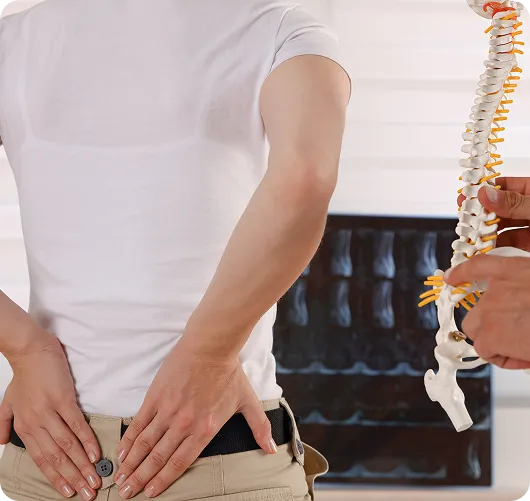Chronic Lower Back Pain Treatment
Minimally invasive care to relieve pain and improve mobility

Understanding Chronic Lower Back Pain
When back pain lasts for more than three months, it is considered a chronic condition. This type of discomfort affects the lumbar region, including the back and legs. It can impact individuals at any stage of life and significantly interfere with daily activities and quality of life.
Chronic back pain affects 8 out of 10 people in the U.S. and is a leading cause of mobility issues, reduced productivity, and in some cases, disability. Understanding the underlying causes and treatment options can empower individuals to manage their symptoms and seek appropriate care.
Treatment approaches typically involve a combination of lifestyle changes, physical therapy, and minimally invasive interventions—such as MILD® or Vertiflex—that offer symptom relief without extended recovery time.
Understanding Chronic Lower Back Pain
When back pain lasts for more than three months, it is considered a chronic condition. This type of discomfort affects the lumbar region, including the back and legs. It can impact individuals at any stage of life and significantly interfere with daily activities and quality of life.
Chronic back pain affects 8 out of 10 people in the U.S. and is a leading cause of mobility issues, reduced productivity, and in some cases, disability. Understanding the underlying causes and treatment options can empower individuals to manage their symptoms and seek appropriate care.
Treatment approaches typically involve a combination of lifestyle changes, physical therapy, and minimally invasive interventions—such as MILD® or Vertiflex—that offer symptom relief without extended recovery time.

Causes of Chronic Lower Back Pain
Chronic lower back pain can be caused by multiple factors, including:
Musculoskeletal issues: Muscle and ligament strains or imbalances could contribute to the development of chronic back pain.
Nerve compression: When the spinal nerves do not have enough space, they become compressed, leading to pain and discomfort in the lumbar region.
Disc degeneration: The intervertebral discs can wear down as the spine ages, causing back pain. Injuries: Trauma from the workplace or sports injuries could cause severe damage to the spine, leading to long-lasting back pain.
Injuries: Trauma from the workplace or sports injuries could cause severe damage to the spine, leading to long-lasting back pain.
Other medical conditions like arthritis, osteoporosis, or spinal stenosis could also be the underlying cause of chronic back pain.
Symptoms of Chronic Lower Back Pain
Some of the most common symptoms related to chronic lower back pain include:
✔ Pain and discomfort: Persistent, throbbing sensations in the lumbar region lasting over three months.
✔ Stiffness and limited mobility: Difficulty bending, running, or jumping due to reduced spinal range of motion.
✔ Numbness and tingling: Sensations affecting the lower back and legs.
✔ Weakness in the legs: May cause imbalance and coordination issues while walking.
Diagnosis of Chronic Lower Back Pain
To diagnose chronic lower back pain, your healthcare provider may follow these steps:
Examine your family’s medical history for any signs of genetic predisposition to spinal issues.
Perform a physical examination of your lower back area and legs.
Perform imaging studies like X-rays, MRIs, and CTA scans.
Perform additional diagnostic tests like blood tests or nerve conduction studies.
Chronic Lower Back Pain Treatment Options
Some of the best treatments for chronic lower back pain include the following options:
Conservative Treatments
Conservative treatments are non-invasive procedures that use physical therapy or exercises to alleviate pain symptoms. To help reduce discomfort in the lumbar area, your healthcare providers may initially recommend trying treatment options, such as massage therapy, acupuncture, or chiropractic care.
These can be used along with other minimally invasive intervention options or non-opioid medication. Also, various lifestyle changes may significantly reduce pain. This can include performing low-impact exercises, keeping a healthy weight, using ergonomic chairs, and having good posture when sitting down.
Non-Opioid Medications
Non-opioid medications recommended by your health specialist can help reduce spinal swelling and nerve pressure. These may range from the following options:
✔ Anti-inflammatory medications
✔ Muscle relaxants Antidepressants
Injections
Unlike local anesthetics, injections offer longer-lasting relief for patients with chronic back pain. As the medication is injected into the epidural space, it will flow all around your spinal cord, allowing the anesthetic to block pain signals:
✔ Steroid injections help provide quick inflammation reduction and symptom relief. They target the nerves that send pain signals into the brain, blocking them almost instantly.
✔ Facet joint injections are targeted into the joints located on the vertebra, which could be causing nerve compression.
Pain Management Procedures
These techniques interrupt pain signals sent to the brain:
✔ Radiofrequency stimulation to disrupt nerve signals
✔ Spinal cord stimulation to modify nerve activity and reduce pain perception
Neuromodulation
Neuromodulation uses electrical nerve stimulation to help reduce the lumbar stress caused by lower back pain. Transcutaneous electrical nerve stimulation (TENS), for example, involves the usage of low-voltage electrical currents to disrupt the transmission of pain signals.
On the other hand, peripheral nerve stimulation uses electrical stimulation to target peripheral nerves around the spinal cord.
Minimally Invasive Interventions
When patients undergo a minimally invasive intervention, there is no need for complete anesthesia or complex surgical processes, and their recovery process is a lot faster. Some of the best minimally invasive interventions to treat chronic lower back pain include:
✔ Microdiscectomy: This procedure involves removing a portion of the damaged disc that is causing pressure on the spinal nerves, relieving pressure and alleviating pain.
✔ Laminectomy: This procedure partially removes the lamina (the arch in the vertebra) to release pressure and reduce pain.
✔ ZIP® Procedure: This spinal fusion technique provides significant pain relief for patients dealing with moderate to severe lumbar spinal stenosis and degenerative disc disease. It uses a minimally invasive approach to stabilize the spine without traditional open surgery.
RESTORE Clinical Trial
Spinal Diagnostics is proud to be involved in the RESTORE Clinical Trial, a new and ongoing clinical research sponsored by Mainstay Medical. The study aims to prove further the safety and benefit of this exciting new therapy for chronic back pain patients.
You may be a good candidate for this trial if you have chronic back pain without significant radiating leg pain and have never had surgery. Please contact us if you are interested in participating in the trial.

Care That’s Close to Home
We offer care from two convenient clinic locations, making it easy to access expert medical support close to home.
Each facility is designed to provide a welcoming, safe, and efficient environment equipped with advanced technology and supported by a compassionate team dedicated to your well being.
Tualatin Clinic
Newberg Clinic
Care That’s Close to Home
We offer care from two convenient clinic locations, making it easy to access expert medical support close to home.
Each facility is designed to provide a welcoming, safe, and efficient environment equipped with advanced technology and supported by a compassionate team dedicated to your well being.
Tualatin Clinic
Newberg Clinic

Why Choose Spinal Diagnostics?
Patients choose Spinal Diagnostics for our comprehensive approach, accurate diagnostics, and compassionate care. We stay at the forefront of interventional procedures and are committed to improving your quality of life—without opioids or invasive surgeries.
Proven Medical Expertise
We bring years of clinical experience in pain management and interventional procedures.
Constant Innovation
We use the latest techniques and technology to ensure safe, effective treatment.
Compassionate Care
We listen, understand, and treat every patient with empathy and respect.
Personalized Plans
Each treatment is tailored to your condition, goals, and lifestyle.
Explore the treatments that bring real relief.
Learn how our non-invasive solutions and personalized plans can help you feel better, faster.
Explore the treatments that bring real relief.
Learn how our non-invasive solutions and personalized plans can help you feel better, faster.

